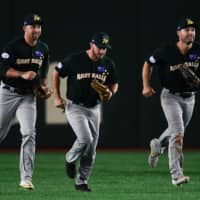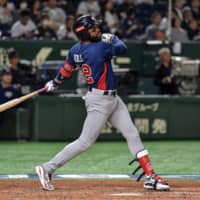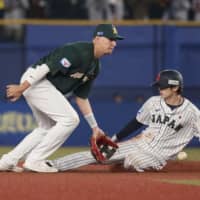Japan’s stellar pitching makes it one of the championship favorites in any international events it competes in.
But it’s hard to win a lot of games without ample run support.
That’s a pressing issue facing Samurai Japan as they aim for the gold medal at next year’s Tokyo Olympics.
After the team took its first loss of the Premier12 on Tuesday in a 4-3 defeat to the United States 4-3 in the Super Round, Japan bench coach Makoto Kaneko hinted that it might be the time to rearrange a batting lineup that has struggled to be effective.
Acknowledging the difficulty of getting hits off unfamiliar pitchers, Kaneko said that the U.S. contest was an example of a game that could have been won with a timely swing.
“You’re not going to score a lot of runs all at once, even at (a hitter-friendly) Tokyo Dome,” Kaneko said. “We want to score one run at a time even when we have runners on second and third (as we did in the seventh inning). But that’s baseball. We played a typical game that we could’ve won with one more (big) hit tonight.”
Although some of the country’s top-notch hitters such as Yuki Yanagita and Hotaka Yamakawa are absent from the Premier12, Japan’s squad is still loaded with all-stars.
Some of those players, however, have struggled to perform as well as they have in domestic play.
Through Tuesday’s game, two-time Central League MVP Yoshihiro Maru of the Yomiuri Giants has gone just .111 with four strikeouts. This year’s leading CL MVP candidate Hayato Sakamoto, also of the Giants, boasts a .200 average with five Ks. Left-handed hitting wizard Kensuke Kondo of the Hokkaido Nippon Ham Fighters has come up with a .214 average, slightly under Japan’s overall hitting average of .236.
Kondo and Yoshida have hit in the No. 3 and 5 slots, respectively, while cleanup hitter Seiya Suzuki has done well (.471, three homers and 10 RBIs). Kaneko, who contributed to Japan’s bronze medal at the 2004 Athens Olympics, said that Kondo and Yoshida have been too passive.
Kaneko said that unlike the familiar pitcher rotations of the NPB season, players have struggled against a constant stream of new faces at international tournaments, suggesting that players able to refresh their minds after each game are still capable of big performances.
“You’re facing different pitchers every day, so there’s not really much you can do,” Kaneko said. “It’s become clearer (throughout the tournament) that we have guys that can move on to the next game with a new mindset and guys that cannot.”
He added that the poor timing of Japanese hitters is “nothing new” at international tournaments, noting their high kick when swinging the bat.
“It’s been so since several years ago, hasn’t it,” said Kaneko, who played infield and currently currently coaches for the Fighters. “That’s particularly the case with the hitters who kick their legs high up and the pitch comes while their legs are still up in the air. I assume they’ve realized that it is an issue. But after playing in a long season in Japan, it’s a daunting task for them to adjust that here.”
The 44-year-old Kaneko doesn’t think the kicks are Japan’s sole problem, pointing out that players such as Suzuki and Hideto Asamura have done well at the plate thanks to their willingness to swing at hittable pitches.
Asamura, who drove in all three runs with three hits for Japan against the U.S., stressed the importance of taking advantage of erratic pitches before falling behind in the count, when pitchers are more likely to make difficult pitches.
“You’ve got to take your swing and make sure you don’t miss a hittable pitch,” the Tohoku Rakuten Golden Eagles infielder said.
Source : Baseball – The Japan Times


